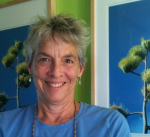Words on the Surface, Redux
 Tuesday, March 6, 2007 at 08:51PM
Tuesday, March 6, 2007 at 08:51PM
Putting text to the test, we creative women printed, dyed, batiked, stamped and calligraphed through the weekend. Candid comments took my planning to the next step, toward turning this workshop into a proposal for on-the-road teaching. The upside: it seems to be an intriguing topic, one that can take participants in many directions. It works for both advanced professionals and for beginning students (with a bit of tweaking and not too many in a class). The techniques taught can be applied to work of different scale and different formats. Downside: it takes a lot of supplies.
Here are some of the samples I made, and some of the results from participants, as well as a few candid shots of the artists (Mary Ann Johnson, Elizabeth Romanella, Caryl Gaubatz, l to r). The samples are some of Kathy Hayson's pieces. We used soy batik, thermofax printing with shaving foam, sun printing, original stamps and other techniques -- and combined and layered them to create Complex Cloth.
Our intent in these samples shown was to embed the text messages into the surface of the cloth, with the form holding as much importance (and as much of the "message" as any literary element. That could mean really making it disappear or become a surface texture, or, if we wanted the words to still be legible, finding ways to integrate surface color and texture.
I'm open to ideas and suggestions, and would love to collect jpg examples of other artist's works to include in a slide show for future events -- with due credit of course. If you are interested in being part of this teaching aid, please contact me though the comments section.
 Workshops
Workshops 






